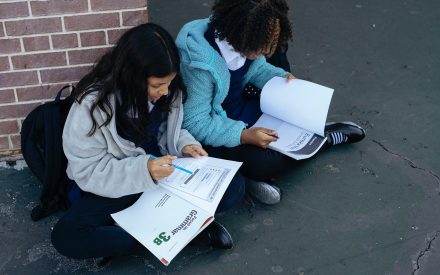There are many resources available to parents on understanding the school system how to be more involved.
One of the keys to achieving high school graduation and pursuing higher education is family involvement. However, language, cultural, and economic barriers can make being involved in children’s education more difficult. Parents who do not speak English may feel uncomfortable getting involved with their children’s schools or have trouble communicating with teachers. Parents may also be unfamiliar with the U.S. school system and lack the necessary resources to help their children navigate through school. Furthermore, strict work schedules can make things like attending school events and helping children with homework nearly impossible. Despite the barriers, high school graduation and higher education are possible!
How to Be More Involved
In order to be involved with their child’s academics, the parent can make sure their child is doing well both academically and mentally. The parent should check their child’s progress in school and make sure they are taking the classes they need to graduate high school. Parents should also make sure their child is doing well mentally and always try to communicate with them and let them know that they will be there for the child whenever the child needs it. To be more involved, they should try attending school events or any events the child is interested in school wise, and also make sure their child is doing well socially.
It doesn’t matter if the parent never got their own education; all that matters is encouraging their child to succeed! If parents feel like they are not capable of helping their child out academically, there are resources available at schools such as tutoring and mentoring that will help their child.
Understanding the U.S. School System
In the U.S. school system, students go to school for 12 years. They start elementary, or primary school, around the age of 6 and stay there from kindergarten to fifth grade. After elementary school, they go to secondary school, consisting of middle school and high school. Students typically go to middle school from 6th to 8th grade, but it can also extend to 9th grade. High school is for students between 9th grade to 12th grade. After finishing up with high school (typically finishing the 12th grade), students graduate from high school and collect their diploma. After graduating high school, students can pursue a college education.
The school year typically lasts from August to June. Students are legally required to attend schools generally from age 5 to 18, although it varies in each state. Visit this link for more information on the ages for mandatory school attendance.
In the school system, the student gets a grade point average (GPA), which measures the students’ academic progress. Schools can use unweighted or weighted GPA. In the unweighted scale, it only goes from 0 to 4.0, meaning this scale measures every class equally, even honors and AP classes. The weighted GPA scale can go from 0 to 5.0, depending on whether the school offers AP classes or not. This scale evaluates the difficulty of the course, meaning an A in an AP class will not be the same as getting an A in a regular class. There are also different levels of classes, which go from regular, honors and AP classes. Honors and AP classes offer a more rigorous coursework than the regular classes, but only AP classes can provide students with college credit. After taking the AP class, the student has to take an AP exam and depending on their score they can get college credit for the course. Not every school offers AP classes and the difficulty between honors and AP varies, but the two can show colleges how students handle difficult coursework. It is recommended for students to check with their counselor to know their progress and what class best fits them.
Benefits of a High School Diploma
- A diploma leads to more job opportunities. As of 2016, 36% of jobs require at least a high school diploma.
- People with high school diplomas are less likely to participate in risky behavior such as, drug use, underage drinking, and other criminal activity.
- People with high school diplomas make approximately 10, 386 dollars more than those without.
- A diploma makes it possible to go to college, whether that’s a local community college or a 4-year university.
Videos
- What happens in the brain of an adolescent? (Spanish)
- How to handle bullying or cyber bullying (Spanish)
- How to help your child develop a positive self-esteem (Spanish)
- Emotional Intelligence (Spanish)
- How to communicate effectively with your children (Spanish)
- The dangers of being a helicopter parent (Spanish)
- How to help your child succeed in school (Spanish)
- How to raise resilient children (Spanish)

 Cómo el programa Juntos empodera a los estudiantes latinos y a sus padres
Cómo el programa Juntos empodera a los estudiantes latinos y a sus padres Recursos de educación superior para padres
Recursos de educación superior para padres Recursos de educación superior para estudiantes
Recursos de educación superior para estudiantes


